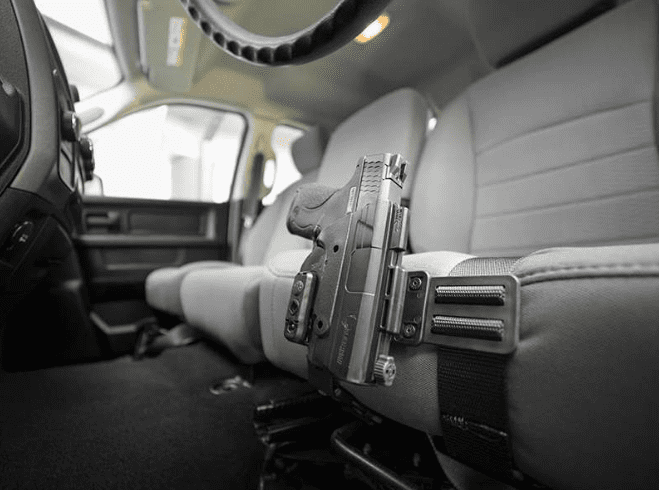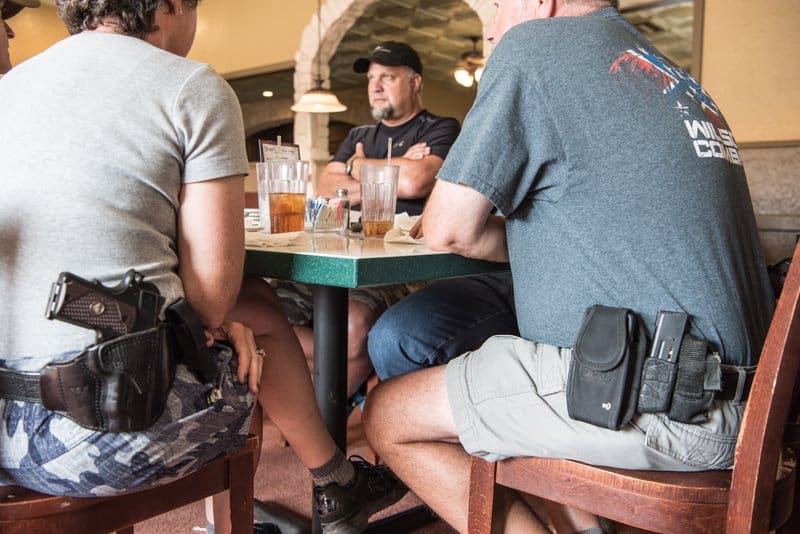Stop for a minute and think how much time you spend in a seated position. Whether it’s in your car, behind a desk at work, or eating in a restaurant, we all are sitting for a significant portion of our day. That requires you to give some serious thought and consideration to how to access your gun if the need arises.
Hitting the Road
For many of us, the commute to and from work takes up a huge portion of our day. Here in my home town of Austin, we spend a lot of time sitting in traffic. The live music capital of the world is ranked 13th in the nation when it comes to rush hour traffic. Even off-peak traffic can be a drag and keeps you in a seated position far longer than you’d want.
Given the frequency and duration of our time behind the wheel, there’s a chance that you may have to draw your gun while seated in your car. Road ragers, carjacking, and other types of violent criminal activities can test your ability to clear your cover garment while inside your vehicle.
The biggest obstacle to an effective draw from within a vehicle is the seat belt. It can be adjusted, but what you don’t want to do is weaken its effectiveness or ability to protect you in a crash.
The seat belt should ride low across your lap, right at the hip joint. That’s the best position to arrest movement and minimize injury, but it’s not the best position for drawing a gun.
One way to work around that if you know you’ll be in your car for a long time is changing where you carry. Traditional three to six o’clock positions can conflict with the seat belt and require you to lean forward and left to draw. Appendix carry is also problematic and can be extremely uncomfortable in the car. When seated behind the wheel, carrying in a crossdraw position makes the draw much easier and faster and usually avoids any entanglements with the seatbelt. An ankle holster can also be much more accessible in a hurry while seated than a pistol carried in a traditional strong-side position.If you don’t want to change your carry position, try placing the shoulder restraint portion of the belt behind the butt of the gun, depending on where you usually position your holster. If your state has an open carry law you can also clear your cover garment in advance, minimizing that obstacle.

Alien Gear Driver Defense holster
Clearing the Table
Whether your eat lunch at your desk, in a lunch room or outside of work, you most likely do it while sitting. The challenges you face aren’t just the draw stroke, but also the sitting arrangement and safety. Are you in a booth or a chair? If you’re in a booth, you’re much more restricted as you usually can’t move either the table or your seat. Ideally, if you’re in a booth, you’ll sit on the outside so you can shift your position, stand up quickly or otherwise maneuver.
courtesy AP
American Workaholics
Most of us sit at a desk for much of the work day. That gives you a certain advantage as you “own the space.” You know the layout, where the exits are and generally who does and doesn’t belong in the area.
If you add some force protection measures such as controlled access, closed circuit monitors and ballistic resistant material it, that can give you a distinct advantage. Still, there are plenty of challenges such as clearing your field of fire.
At the very least, design and implement an active shooter plan for your workplace. Know and rehearse what to do if you are at your desk and what to do when you’re away.
The last point to consider is that no matter where you may be, drawing from a seated position is dangerous and should only be performed if absolutely necessary. It can be extremely difficult to do so without lasering yourself or others around you. Practice definitely helps, but if at all possible, stand and safely draw your firearm per your standard SOP.
We spend far more time seated than you might think and knowing the most effective and efficient ways to access your gun is always important. But all of the four safety rules still apply. Remember that you need to manage friendlies nearby along with the unknowns while still being sure of your backstop.
Jeff Gonzales is a former US. Navy SEAL and preeminent weapons and tactics instructor. He brings his Naval Special Warfare mindset, operational success and lessons learned unapologetically to the world at large. Currently he is the Director of Training at The Range at Austin. Learn more about his passion and what he does at therangeuastin.com.












![[VIDEO] The Newest Scary Addition To The Holster Industry: The Handgun Sling™](https://imagedelivery.net/sbm_lYeJbALkepJgtmRD5w/concealednation.org/2015/08/ScreenHunter_129-Aug.-31-11.30.jpg/w=728,h=381)

